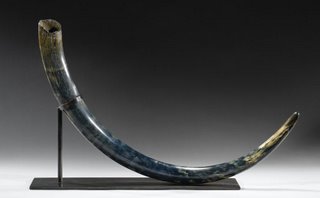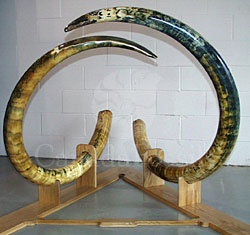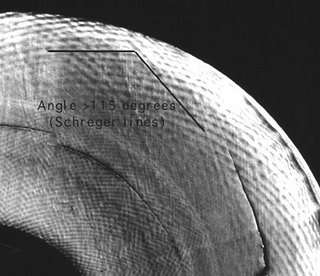 Blue-hued mammoth tusk from the Tamyr peninsular, Siberia, which sold at Sotheby's Billingshurst sale (below) on 26 Sep 06 for GBP£6,000 (est£2.5k), 102cm.; 40ins on outside curve.
Blue-hued mammoth tusk from the Tamyr peninsular, Siberia, which sold at Sotheby's Billingshurst sale (below) on 26 Sep 06 for GBP£6,000 (est£2.5k), 102cm.; 40ins on outside curve.WOOLLY mammoth tusks are often the top lot of the fossil section of
Sotheby's sales of 'Garden, Architectural and Fossil Decoration'. Fossils have always had a following from collectors, but their increase in popularity may be a result of the art world's move into the natural, deathly, sensational and anatomical, by people like Damien Hirst. Movements in art influence exterior and interior design, and fossils are one of the nearest things you can get to tasteful and naturally decorative sculpture made into durable materials from the death of animals and plants. Death and anatomy are recurring themes of Britpop. Fossils are perhaps a more acceptable way to represent them. Fossils are attractive because they will fit with stark minimalist interiors as well as junk-filled maximalist ones, although I have never seen a millionaire's retreat with interiors tastefully decked out in ammonites, trilobites, knightia fish and the odd mammoth tusk (publishable photo's gratefully received).
Fossils are strictly-speaking mineralised organic matter, which means living things turned to rock. Although you can find fossilised mammoth tusks up to 1.6m years old, those sold at auction tend to be real 20,000 years old ivory that has been preserved by being buried, often in bogs or alluvium, where the lack of oxygen has prevented their natural decay. Mammoths became extinct 3,500 years ago due to global warming and hunting by paleolithic man.
The recent global warming in places like Siberia results in melting ice and tundra, and soil erosion which exposes buried mammoth skeletons. Greater mineral exploitation, small aircraft, quads and four by fours, general mobility and local awareness of value, means more and more fossils will find their way to the relatively rich western markets.
Practically anything removed and sold results in accusations of desicration and profiteering. The world of architectural and garden antiques is familiar with that sentiment by conservationists. Now archaeologists are at loggerheads with fossil-hunters. A long ethical argument is described in the
story of Confuciusornis sanctus in China, where fossil hunting is banned. In most parts of the world, collecting fossils from private land with the owner's permission is perfectly legal.
Butterfields in San Francisco is an auction house well known for its regular architectural and decorative antiques sales, where fossil selling has generated more of a public debate between academics and fossil-hunters. In 2001 a Siberian woolly mammoth tusk sold for $32,000 at Butterfields.
 US Geologists on a field trip to Wrangel Island in north-east Siberia came across quite a few mammoth tusks, and took this photo of a local who had picked this one up - no doubt to pass it into the global dealer network. [Photo: Lyn Gualtier
US Geologists on a field trip to Wrangel Island in north-east Siberia came across quite a few mammoth tusks, and took this photo of a local who had picked this one up - no doubt to pass it into the global dealer network. [Photo: Lyn Gualtier"Things are being lost to science because we don't have enough people out there looking. There are not enough degreed paleontologists or tax dollars . . . to look at nearly a half-billion acres of public lands, let alone private lands,"
said Marion Zenker, marketing coordinator for the Black Hills Institute in South Dakota, a leading commercial fossil excavator. Zenker, a plain-spoken former tractor-trailer driver and mother of eight, said academic hunters "act like the high priests of paleontology." Robert Bakker, the Harvard and Yale trained paleontologist who helped advance the idea that dinosaurs were warmblooded, has said many of his colleagues promote a class system. "We guys with PhDs think we have a God-given right to dictate where and how specimens are collected," something Bakker said is not in the public interest. Zenker adds that scientific credentials should not be the only entry into a fossil dig: "The people who are in this field are here because they love fossils." Zenker's Black Hills Institute found Sue, the world's most famous Tyrannosaurus rex. And the world's most costly. Sue sold at a Sotheby's auction in 1997 for $8.4 million - leading to fear that important dinosaur fossils would be priced out of the reach of museums. Sue's story ended happily; corporate benefactors sponsored her donation to Chicago's Field Museum of Natural History. There is a
comprehensive set of Fossil Protection Links on a site compiled by W Douglas Boyce, a Canadian paeleontologist.
Ivory Jack's website describes how mammoth tusks are found. It also describes their colour. 'The beautiful hues of tan, brown and blue are a result of thousands of years of mineralization. Exact hues depend upon the mineral deposits in the immediate soil surrounding the fallen mammoth.' There are more hued tusks, and also a complete skeleton, for sale at
Arizona Skies.
Woolly mammoth tusks have another ethical dimension: they are real ivory, and new ivory trading is protected under CITES regulation. However the sale of antique and prehistoric ivory is unregulated. How do you tell elephant from mammoth ivory? A section through both elephant ivory and mammoth ivory show natural cross-hatching. The angle between the cross-hatches can be an absolute test, outside the range 90 degrees - 115 degrees. Between these two figures a precise indentification is impossible. Clearly with single tusks this test will not work, unless a section has been cut and polished.
Whole mammoth tusks tend have flattened ends, roughly the last third towards the points, and have are often marked and worn on the undersides where it is believed they were used for foraging. They frequently wrapped inwards towards each other. Male tusks are thicker, more three-dimensionally curved and longer than female tusks. The longest mammoth tusks discovered are 16ft long.

 A matched pair of mammoth tusks, with inward interlinked curvature described above. They are not always curved like this. [Photos: Canada Fossils
A matched pair of mammoth tusks, with inward interlinked curvature described above. They are not always curved like this. [Photos: Canada FossilsHo do you tell real ivory from bone or resin replica? Much of the real ivory antique netsuke replica is carved in workshops in Hong Kong. The
Asian Arts website describes, not only the hot pin test to tell the difference between ivoyr and resin, but also whether it is real ivory (hardenend dentine) or plain bone. It also gives pointers as to which animal the ivory may come from. The test is to take a pin or large needle, or large straightened out safety pin, and heat the tip red hot, then stick it into the item. If ivory, the pin will not penetrate but will only leave a tiny mark. If resin, it will go straight into the item and leave a raised area around the hole. If ivory, the smoke will smell of drilled tooth that you get at the dentist's. If it smells like burning plastic, it is resin. Bone is resistant to heat, but not as much as ivory. The smell is less (or hardly at all) and is different than that of burning tooth. Bone is free of grain and will always have little "pock marks" (sometimes brown) where the marrow was, visible with a magnifying glass. If it has any grain, especially crosshatching, you have the real ivory.
Planet Ark the eco-website says, 'Mammoth ivory, now starting to come onto the market in large quantities as global warming thaws the permafrost in Canada and Russia and exposes the corpses of the long-dead woolly giants, is virtually indistinguishable from elephant ivory. However, unlike elephant ivory, mammoth tusks smell, and are harder to work.'
 Another way to make check that the blue stained on mammoth tusk is real and not fake is to check for blue 'vivianite' using ultra-violet light. The photo shows vivianite on a mammoth tusk found at the Pamir Peninsula, Siberia. The tusks of mammoths are made of enamel externally and dentin internally. The dentin is calcareous and similar to bone but softer and chemically more active. Vivianite, a hydrated ferrous phosphate Fe3(PO4)2·8(H2O), and dentin, can form thin coatings on the damaged surfaces of fossilizing tusks. Vivianite goes darker on exposure to light. [Photo: Copyright © 2003 Giraud Foster & Norman Barker
Another way to make check that the blue stained on mammoth tusk is real and not fake is to check for blue 'vivianite' using ultra-violet light. The photo shows vivianite on a mammoth tusk found at the Pamir Peninsula, Siberia. The tusks of mammoths are made of enamel externally and dentin internally. The dentin is calcareous and similar to bone but softer and chemically more active. Vivianite, a hydrated ferrous phosphate Fe3(PO4)2·8(H2O), and dentin, can form thin coatings on the damaged surfaces of fossilizing tusks. Vivianite goes darker on exposure to light. [Photo: Copyright © 2003 Giraud Foster & Norman Barker
 If you have a polished section through the tusk it is possible to tell elephant from mammoth using the Schreger lines, or cross-hatching. If the angle between them is greater than 115 degrees it is elephant. If the angle is less than 90 degrees it is mammoth. [Photos: U.S. Fish & Wildlife Services forensics laboratory
If you have a polished section through the tusk it is possible to tell elephant from mammoth using the Schreger lines, or cross-hatching. If the angle between them is greater than 115 degrees it is elephant. If the angle is less than 90 degrees it is mammoth. [Photos: U.S. Fish & Wildlife Services forensics laboratoryAnother website with close-ups of
Mammoth Tusks explains the difference between Siberian, American (bigger) and European mammoths (smaller with curvier tusks, many of which are still being trawled up in the north sea by Dutch fishermen. 'This fossil specimen is not subject to any bans. It can be legally owned and shipped to anyone anywhere. They are one of the most popular large display fossils of any collection. The woolly mammoth is the mascot animal of the Earth's final Ice Age.'
Enchantment with fossils and buried tusks goes back to Roman times. It is fair to say that the Romans were obsessed with fossils. Much of the mythology, especially legends of giants, has been attributed to the discovery of large buried fossils. The legend of the Caledonian Boar is believed to have come from fossil remains, possibly even woolly mammoth tusks. The web page
Accounts of Greek and Roman Paleontology says, 'In 31 BC, the future emperor Augustus plundered the great tusks of the mythical Calydonian Boar from a temple in Tegea, Greece, and installed them in Rome. These were most likely prehistoric elephant tusks dug up in Pleistocene fossil beds near Tegea. Some 400 years later the historian Procopius saw a great pair of tusks labeled "from the Calydonian Boar" at Beneventum, Italy. He described them as "well worth seeing, measuring three hand-spans around and curved in a crescent shape," which suggests that the "Calydonian tusks" at Beneventum were a pair of woolly mammoth tusks, common fossil remains in Italy.'
Site
 A SG$16,000 (£5,350) Qing dynasty 100 year old horse-drawn rickshaw in the half-acre Food Republic's latest cafe a VivoCity in Singapore [Photo Mohd Ishak
A SG$16,000 (£5,350) Qing dynasty 100 year old horse-drawn rickshaw in the half-acre Food Republic's latest cafe a VivoCity in Singapore [Photo Mohd Ishak
 One of Breadtalk Group's hallmark 'see thru' plate glass high street bakeries.
One of Breadtalk Group's hallmark 'see thru' plate glass high street bakeries.


























